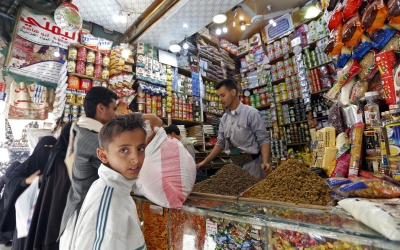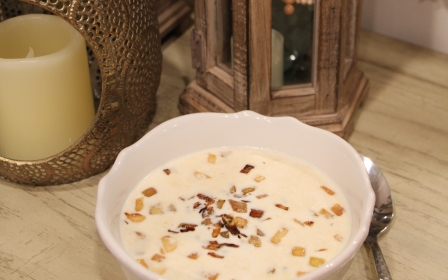When life gives you locusts: Yemenis turn a plague into dinner during Ramadan

Just as Yemenis were preparing for the beginning of the Muslim holiday of Ramadan earlier this month, a threat loomed on the horizon. This time, it was not air strikes, as has been the case for more than four years since the beginning of a Saudi-led offensive in the country, but red desert locusts, swarming for the first time in the country in three years.
On the first night of Ramadan on 5 May and for days afterwards, farmers on the western outskirts of Sanaa observed throngs of flying locusts descend on the Hamdan, Arhab and Bani Matar districts of Sanaa governorate.
The invasion came with Yemen in the grip of a desperate food crisis, prompting villagers to rally to catch the insects and save their crops.
According to the World Food Programme's (WFP) latest food security assessment, 20.2 million - about 76 percent of the total population - would be facing life-threatening shortages of food without humanitarian assistance. Only 25 percent of all food is produced domestically in Yemen, which is otherwise reliant on imports.
But with over 10 million Yemenis one step away from famine according to WFP, locusts have turned into an unexpected blessing.
New MEE newsletter: Jerusalem Dispatch
Sign up to get the latest insights and analysis on Israel-Palestine, alongside Turkey Unpacked and other MEE newsletters
A threat to food security
Wajeeh Mutawakel, the director general of the Plant Protection Office in Houthi rebel-controlled Sanaa, told MEE that several factors have alleviated the locust swarms' impact on Yemen's food production.
According to Mutawakel, because the "growing season for cereal and vegetable crops is just beginning" in Yemen, this has lowered the immediate threat level to food security in Yemen.
However, Mutawakel said there is no doubt that locust swarms pose a threat to food security in Yemen. "One swarm covering one square kilometers contains 50 million locusts, and this swarm can eat the equivalent of 100 tonnes per day," he noted.
Houthi-run news agency Saba reported on 5 May that senior officials at the Houthi-run Ministry of Agriculture warned of the negative effects of the locust swarms over large areas in the Sanaa, Amran, Saada, Jawf and Mareb governorates.
While locusts caused relatively little damage in Sanaa, Amran and Saada, Mutawakel said grains and citrus trees in Jawf and Mareb were considerably affected.
While a few straggling grasshoppers could still be seen around Sanaa three weeks after the initial invasion, swarms have been spotted in the Ibb governorate in recent days, Mutawakel said.
Mutawakel noted that his office was cooperating with the United Nations Food and Agriculture Organisation to help fight the insect invasion with trucks spraying insecticide.
But he said the Plant Protection Office was struggling to obtain spraying trucks and was faced with a lack of funds, staff, and equipment to address the issue properly.
Mutawakel stressed that red locusts could still exacerbate the spectre of starvation in Yemen if intense rainfall occurs in June, as predicted by meteorologists.
"This may cause disaster not only in Yemen but also in other countries, such as in Saudi Arabia."
However, the official said that Yemenis used unorthodox means of dealing with the locust invasion.
"Yemenis are fond of eating locusts," he said.
How to catch a pest
Three days after locusts descended on the Bani Matar district, Ahmed al-Haqash left the Yemeni capital, where he lives most of the time, to check on his potato farm.
Haqash held his breath, thumbing the beads of a rosary between his fingers as he entered the village of Beit al-Haqash. The 57-year-old was welcomed by a group of locals who came to shake his hand, when a man wearing a military uniform got out of a grocery store carrying a sack of fresh locusts he had gathered the night before.
On his way to the farm, Ahmed was reassured by his neighbour, Ameen al-Haqash: his potatoes were left unscathed by the locusts. Ameen's field of arugula, however, was partially destroyed.
As he held leaves of arugula between his fingers to show the damage inflicted by the swarm of insects, Ameen, 35, nonetheless said he was happy and proud of locals for being able to catch up locusts with traditional methods as they descended upon the village.
The farmer said the villagers caught locusts at night, when the grasshoppers are not flying. With flashlights on their foreheads, the villagers throw scarves or other large bits of cloth over the insects to trap them, before sweeping them into sacks using shovels or their bare hands.
Ameen said he gathered about 10 sacks of locusts on his own, adding that some other families had gathered 20 to 30 sacks depending on how many relatives joined the hunt.
"If locusts had remained for five minutes, they would have wiped out the entire crops," Ameen told MEE. "But we wiped them out before they wiped out crops. In a matter of five hours, the village was free from any danger of the locusts.
"Instead of them eating our vegetables, now we eat locusts with rice and our vegetables are fine," the farmer added. "Locusts swept the entire Arab region, but when they arrived in Yemen, Yemenis eliminated them."
Highlighting the local history of locust scavenging, some residents of Beit al-Haqash claimed that in the 1960s, one since-deceased villager had given his in-laws a sack of locusts as a bridal price ahead of his wedding.
Now, some farmers who gathered locusts in the Bani Matar district have taken sacks of them to Sanaa to sell either fresh or grilled on the side of the road near Sanaa's Great Mosque.
Fresh, roasted or fried
In the old city of Sanaa, children and elderly men and women sit by the side of the road, selling locusts, most of which were caught in the Bani Matar district.
A locusts retailer sits outside Bab al-Yemen, one of the old city gates, waiting for clients, his goods packaged in sacks and large plastic bottles.
"They are crops themselves," the seller, said.
Jihad, an eight-year-old girl originally from Bani Matar, told MEE that she usually sold birds in Sanaa. But the little girl smiled as she scooped locusts up for customers using an old metal can, excited to sell something new.
Farooq al-Jaradi, a father of seven, purchased two bottles of cooked locusts. He tells MEE the sole reason he eats the insects is that they are reportedly a good remedy for several illnesses - including Yemenis claim, diabetes and hypertension.
"Locusts don't threaten food security, especially in Yemen," Jaradi told MEE. "Yemenis eat them before they eat their crops."
Wadai al-Nawdah carried a plastic bag of fresh locusts to cook at home, in the Moussa neighbourhood of the old city.
In the stone-paved alley outside his home, Wadai cooks the locusts on hot coals. Almost immediately, neighbours gather around him to break their fast with the piping-hot bugs.
Unlike other Yemenis who told MEE they mainly ate locusts for their supposed health benefits, 35-year-old Wadai professed an obsession with the six-legged snack.
"Its taste is delicious. If you eat one locust, you will end up wanting to eat five," the father of two said. "I walk every day after breakfast to find locusts for dinner. I have become addicted."
This article is available in French on Middle East Eye French edition.
Middle East Eye delivers independent and unrivalled coverage and analysis of the Middle East, North Africa and beyond. To learn more about republishing this content and the associated fees, please fill out this form. More about MEE can be found here.







